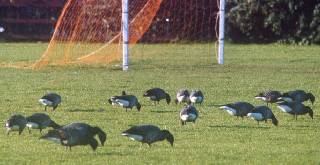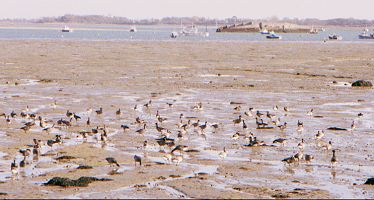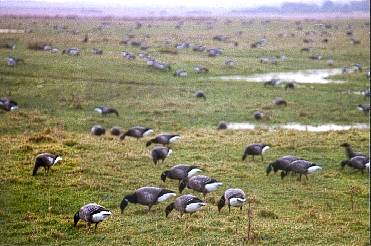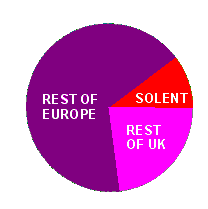Farlington Playing Fields
This site's importance for geese helped to defeat plans for a new football stadium here.

Farlington Playing FieldsThis site's importance for geese helped to defeat plans for a new football stadium here. |
 |
 |
Farlington MarshesLast but not least, this HWT nature reserve attracts the highest number of geese in the area. They are also a lot less timid of human beings than at other sites, so it is possible to get quite close without having to sneak up on them. Family groups can be identified, the adults showing a white neck marking while the juveniles have no neck marking but instead have white stripes on their wings. |
 The geese regularly seen in this area
are the sub-species called Dark-bellied Brent Geese, Branta bernicla
bernicla. They breed on the Taimyr Peninsula in Northern Siberia, and spend
the winter on the east and south coasts of England, and other sites in
north-western Europe. The total (world) population is about 300,000 geese, and
about 100,000 come to the UK, with 30,000 ish coming to the Solent harbours and
coast. Up to 6,500 geese use Langstone Harbour, and about 2,700 use Portsmouth
Harbour (Source : BTO in Brent Goose Strategy). The first arrivals for the
winter are mainly in mid September, although
this date is becoming earlier as the population increases. Geese have proved to
be adaptable and are able to feed on a wide range of plants. In Autumn they eat
algae and eelgrasses in the shallow waters of the harbours. As these sources
become depleted, they move on to grass pastures, winter wheat and other crops.
In Spring, most geese migrate north by the end of March.
The geese regularly seen in this area
are the sub-species called Dark-bellied Brent Geese, Branta bernicla
bernicla. They breed on the Taimyr Peninsula in Northern Siberia, and spend
the winter on the east and south coasts of England, and other sites in
north-western Europe. The total (world) population is about 300,000 geese, and
about 100,000 come to the UK, with 30,000 ish coming to the Solent harbours and
coast. Up to 6,500 geese use Langstone Harbour, and about 2,700 use Portsmouth
Harbour (Source : BTO in Brent Goose Strategy). The first arrivals for the
winter are mainly in mid September, although
this date is becoming earlier as the population increases. Geese have proved to
be adaptable and are able to feed on a wide range of plants. In Autumn they eat
algae and eelgrasses in the shallow waters of the harbours. As these sources
become depleted, they move on to grass pastures, winter wheat and other crops.
In Spring, most geese migrate north by the end of March.